

Click on an icon to get the corresponding image of higher resolution, or a corresponding movie.
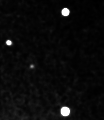 (36614) Saltis
I've discovered and named an asteroid! I named it Saltis after the
nickname of Saltsjöbaden where Stockholm observatory was located between
1931 and 2001. I've written a Saltis web page
with all the details, though only in Swedish. The naming of the asteroid
attracted some local media attention in Sweden, find the references on my publications page.
(36614) Saltis
I've discovered and named an asteroid! I named it Saltis after the
nickname of Saltsjöbaden where Stockholm observatory was located between
1931 and 2001. I've written a Saltis web page
with all the details, though only in Swedish. The naming of the asteroid
attracted some local media attention in Sweden, find the references on my publications page.
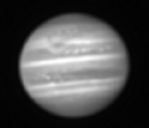 Jupiter by NOT
On 2002-02-27 at 22:30 we had clouds and bad seeing at the
NOT, La Palma. The only thing
visible through the clouds were the full moon and Jupiter. So instead of observing the
real scientific targets (we could not) I pointed NOT to Jupiter and obtained these
images in B- and U-band (blue and bluer filter). I tried to make multi-colour exposures,
but the planet saturated the camera in V ("Visual", Green) and R (Red) even at the shortest
exposure times available (0.1s). The moons Ganymedes and Io are also visible in these images.
Note that the planet has rotated slightly between the exposures. I used 3 x 0.2 seconds exposure
in B and 3 x 0.6 s in U. The brightness of the moons have been increased slightly in comparison
to the planet. Obtained in company of Ilya Ilyin and Ingvar Svärdh.
Jupiter by NOT
On 2002-02-27 at 22:30 we had clouds and bad seeing at the
NOT, La Palma. The only thing
visible through the clouds were the full moon and Jupiter. So instead of observing the
real scientific targets (we could not) I pointed NOT to Jupiter and obtained these
images in B- and U-band (blue and bluer filter). I tried to make multi-colour exposures,
but the planet saturated the camera in V ("Visual", Green) and R (Red) even at the shortest
exposure times available (0.1s). The moons Ganymedes and Io are also visible in these images.
Note that the planet has rotated slightly between the exposures. I used 3 x 0.2 seconds exposure
in B and 3 x 0.6 s in U. The brightness of the moons have been increased slightly in comparison
to the planet. Obtained in company of Ilya Ilyin and Ingvar Svärdh.
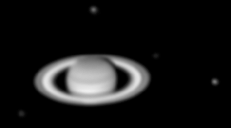 Saturn by NOT
On an observation trip to La Palma and the
Nordical Optical Telescope (NOT) we ended up
with really poor astronomical weather -
clouds and 1.5" seeing (atmospheric turbulence). Our main programme needed high signal
and good seeing (<1"). This was impossible under the given conditions. Even so, the planet
Saturn was bright enough to be captured. This is a B-band (blue filter) image of
Saturn with five of its about 30 known moons. I have enhanced the brightness of the
satellites a bit to be visible in the same image as Saturn. Obtained 2002-02-25 at
23:25 at the NOT in company of René Liseau, Ilya Ilyin and Ingvar Svärdh.
The image is a combination of ten images of exposure times (through the clouds!)
0.7 seconds.
Saturn by NOT
On an observation trip to La Palma and the
Nordical Optical Telescope (NOT) we ended up
with really poor astronomical weather -
clouds and 1.5" seeing (atmospheric turbulence). Our main programme needed high signal
and good seeing (<1"). This was impossible under the given conditions. Even so, the planet
Saturn was bright enough to be captured. This is a B-band (blue filter) image of
Saturn with five of its about 30 known moons. I have enhanced the brightness of the
satellites a bit to be visible in the same image as Saturn. Obtained 2002-02-25 at
23:25 at the NOT in company of René Liseau, Ilya Ilyin and Ingvar Svärdh.
The image is a combination of ten images of exposure times (through the clouds!)
0.7 seconds.
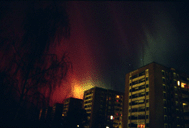 Northern lights over Stockholm
As we approached the solar activity maximum, in the evening of the 6:th of April 2000
there was an absolutely awesome aurora visible from large parts of Europe. I was preparing
to spend the night at the observatory to catch some faint galaxies when I noticed some
very annoying faint greenish clouds close to zenith. Looking more carefully I saw that
the faint clouds changed form very rapidly and realised that it was an aurora. I trashed
my deep sky observing plans and set out to enjoy the northern lights instead, which grew
more and more impressive for every minute. By 22:00 local time the whole sky was covered
with light, flicking from red to green. Unfortunately I didn't bring my camera, but when I
came home at about 01:30 local time, the show was still on and I captured this image from
my window in Nybohov, Stockholm, where I live.
Northern lights over Stockholm
As we approached the solar activity maximum, in the evening of the 6:th of April 2000
there was an absolutely awesome aurora visible from large parts of Europe. I was preparing
to spend the night at the observatory to catch some faint galaxies when I noticed some
very annoying faint greenish clouds close to zenith. Looking more carefully I saw that
the faint clouds changed form very rapidly and realised that it was an aurora. I trashed
my deep sky observing plans and set out to enjoy the northern lights instead, which grew
more and more impressive for every minute. By 22:00 local time the whole sky was covered
with light, flicking from red to green. Unfortunately I didn't bring my camera, but when I
came home at about 01:30 local time, the show was still on and I captured this image from
my window in Nybohov, Stockholm, where I live.
 Moon mosaic
This mosaic of the moon was assembled using 194 CCD images from the 47.5 cm Swedish Vacuum Solar Telescope
(SVST, see image of Luc and the telescope) observed between the 6:th
and the 7:th of August 2000. Shortly after I made these observations
together with Luc Rouppe van der Voort, the
telescope was shut down to be replaced with a new one with a
1 meter aperture.
Moon mosaic
This mosaic of the moon was assembled using 194 CCD images from the 47.5 cm Swedish Vacuum Solar Telescope
(SVST, see image of Luc and the telescope) observed between the 6:th
and the 7:th of August 2000. Shortly after I made these observations
together with Luc Rouppe van der Voort, the
telescope was shut down to be replaced with a new one with a
1 meter aperture.
There is also a large (1.1 MB) version of the Moon mosaic,
3000x4208 pixels.

 Part of the southern Moon
This image is a zoomed in part of the whole Moon mosaic above. To the right is an identification chart
with some craters named. The biggest crater in the image is the crater Maurolycus, named after the
italian mathematician Francesco Maurolico who lived in the early 16:th century and was a devoted
proponent of the Copernican solar centred system. The diameter of the crater is 114 km with mighty
walls extending 4700 metres. The smallest details percievable in this image are about 1 km in size,
which corresponds to roughly an angle of 0.7 arcseconds at the distance of the Moon.
Part of the southern Moon
This image is a zoomed in part of the whole Moon mosaic above. To the right is an identification chart
with some craters named. The biggest crater in the image is the crater Maurolycus, named after the
italian mathematician Francesco Maurolico who lived in the early 16:th century and was a devoted
proponent of the Copernican solar centred system. The diameter of the crater is 114 km with mighty
walls extending 4700 metres. The smallest details percievable in this image are about 1 km in size,
which corresponds to roughly an angle of 0.7 arcseconds at the distance of the Moon.
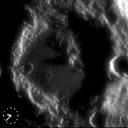 Moving shadows on the Moon movie
During more than two hours before Moon set, Luc and
I used the SVST to take a series of images of the crater Walter on the Moon. Walter was located
at the terminator and was thus experiencing a sunrise. In this movie one can actually see how the
shadows from the crater walls and the central peak get shorter. Not by a large amount, though,
as 140 minutes of sunrise on the Moon corresponds to 5 minutes of sunrise on Earth, since the
rotation period of the Moon is 27 times longer. From a trip to La Palma, August 2000. The mpeg
movie is 56 kB only.
Moving shadows on the Moon movie
During more than two hours before Moon set, Luc and
I used the SVST to take a series of images of the crater Walter on the Moon. Walter was located
at the terminator and was thus experiencing a sunrise. In this movie one can actually see how the
shadows from the crater walls and the central peak get shorter. Not by a large amount, though,
as 140 minutes of sunrise on the Moon corresponds to 5 minutes of sunrise on Earth, since the
rotation period of the Moon is 27 times longer. From a trip to La Palma, August 2000. The mpeg
movie is 56 kB only.
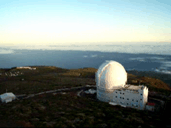 Moving shadows on Earth movie
From the top of the canary island La Palma, where the Swedish solar tower is located together
with a family of other telescopes, one has a splendid view over the surrounding island. Here is
the William Herschel telescope seen from the tower shortly after sunrise. Note how the shadows get
rapidly shorter, and how the clouds in the background below disappear as they rush from the see
towards the dryer mountain side. I made the movie using a Kodak digital camera I borrowed from
the Solar observatory, by taking an image every 30 seconds or so for about 15 minutes. From a
trip to La Palma, August 2000. This mpeg movie is 306 kB.
Moving shadows on Earth movie
From the top of the canary island La Palma, where the Swedish solar tower is located together
with a family of other telescopes, one has a splendid view over the surrounding island. Here is
the William Herschel telescope seen from the tower shortly after sunrise. Note how the shadows get
rapidly shorter, and how the clouds in the background below disappear as they rush from the see
towards the dryer mountain side. I made the movie using a Kodak digital camera I borrowed from
the Solar observatory, by taking an image every 30 seconds or so for about 15 minutes. From a
trip to La Palma, August 2000. This mpeg movie is 306 kB.
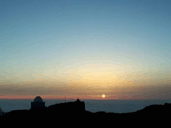
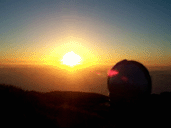 Sunrise and sunset movies from La Palma
From the top of La Palma, 2400 metres above sea level, there is almost always a cloud cover below.
Consequently, the Sun rises and sets in a sea of clouds, at a horizon far away. Sunsets are just
amazingly beautiful. The William Herschel telescope dome in the foreground makes a wounderful
setting for sunsets, here is another picture. From a trip
to La Palma, August 2000. These are mpeg movies of 132 kB and 335 kB each.
Sunrise and sunset movies from La Palma
From the top of La Palma, 2400 metres above sea level, there is almost always a cloud cover below.
Consequently, the Sun rises and sets in a sea of clouds, at a horizon far away. Sunsets are just
amazingly beautiful. The William Herschel telescope dome in the foreground makes a wounderful
setting for sunsets, here is another picture. From a trip
to La Palma, August 2000. These are mpeg movies of 132 kB and 335 kB each.
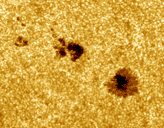 SunSpots
Of course, the solar telescope is mainly intended as a solar telescope and not as a toy
for visiting astronomers to take amateur images, so during the days I assisted
Luc observe the Sun. This is an acquisition
image of a sunspot we observed with a spectrometer. Note the bright grains and the boiling
granules. The yellow colour of the image is artificially put there by me, only intensity
information is recorded in the original image since we used a single filter.
SunSpots
Of course, the solar telescope is mainly intended as a solar telescope and not as a toy
for visiting astronomers to take amateur images, so during the days I assisted
Luc observe the Sun. This is an acquisition
image of a sunspot we observed with a spectrometer. Note the bright grains and the boiling
granules. The yellow colour of the image is artificially put there by me, only intensity
information is recorded in the original image since we used a single filter.
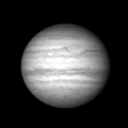 Jupiter movie
Jupiter's rapid rotational period, about 10 hours, makes it possible to observe the
rotational changes of the planetary disc pattern after a few minutes only. In this
time series stretching over 140 minutes, the Great Red Spot is first seen in the upper
centre of the disc, and then slowly rotated out to the right. Watching carefully, one
may even discern the differential rotation, that is, that not all parts of the planet
rotate equally fast. The time series was observed early in the morning, the 11:th of
August 2000 with the SVST. The movie is a 1.68 MB GIF animation.
Jupiter movie
Jupiter's rapid rotational period, about 10 hours, makes it possible to observe the
rotational changes of the planetary disc pattern after a few minutes only. In this
time series stretching over 140 minutes, the Great Red Spot is first seen in the upper
centre of the disc, and then slowly rotated out to the right. Watching carefully, one
may even discern the differential rotation, that is, that not all parts of the planet
rotate equally fast. The time series was observed early in the morning, the 11:th of
August 2000 with the SVST. The movie is a 1.68 MB GIF animation.
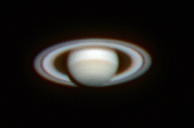 Saturn
With its rings, Saturn is the crowned king of the planets. This image is a colour composite
made from three separate exposures, but the colour matching of the available filters were
not perfect. Notice the shadow cast by the rings on the planet, the crisp Cassini division
in the rings, and the bright white band around the planet. These kind of details are what
you can expect to observe under good conditions with amateur equipment, explaining
why this planet is such a popular sight. From a trip to La Palma, August 2000.
Saturn
With its rings, Saturn is the crowned king of the planets. This image is a colour composite
made from three separate exposures, but the colour matching of the available filters were
not perfect. Notice the shadow cast by the rings on the planet, the crisp Cassini division
in the rings, and the bright white band around the planet. These kind of details are what
you can expect to observe under good conditions with amateur equipment, explaining
why this planet is such a popular sight. From a trip to La Palma, August 2000.
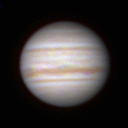 Jupiter
A colour composition of Jupiter. As for Saturn, the colour filters were not perfect,
and in the case of Jupiter the rapidly rotating planet in conjuction with lots of
surface details makes it hard to do colour multiexposures of the planet. Between
the filtered exposures, the planet has rotated a bit which blurs the colour
image slightly. Still, the stark contrasts in the cloudy atmosphere with ammonia
clouds floating around in a sea of hydrogen are easily seen in the coloured bands.
From a trip to La Palma, August 2000.
Jupiter
A colour composition of Jupiter. As for Saturn, the colour filters were not perfect,
and in the case of Jupiter the rapidly rotating planet in conjuction with lots of
surface details makes it hard to do colour multiexposures of the planet. Between
the filtered exposures, the planet has rotated a bit which blurs the colour
image slightly. Still, the stark contrasts in the cloudy atmosphere with ammonia
clouds floating around in a sea of hydrogen are easily seen in the coloured bands.
From a trip to La Palma, August 2000.
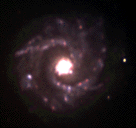 Spiral galaxy NGC3631
It was by examining the picture of the Big Dipper below I found this beautiful spiral galaxy
seen almost face on. The bright clumpy structures in the spiral arms are not stars but HII
regions, regions of hit ionised hydrogen gas. There are plenty of such in our own galaxy
the Milky Way as well. The galaxy NGC3631 looks something like we can imagine that the Milky Way
would look like if we could see it from above, and not from the inside as we do now.
Spiral galaxy NGC3631
It was by examining the picture of the Big Dipper below I found this beautiful spiral galaxy
seen almost face on. The bright clumpy structures in the spiral arms are not stars but HII
regions, regions of hit ionised hydrogen gas. There are plenty of such in our own galaxy
the Milky Way as well. The galaxy NGC3631 looks something like we can imagine that the Milky Way
would look like if we could see it from above, and not from the inside as we do now.
In 1965 Paul Wild discovered a supernova, an exploding star, in this galaxy. Yet another
supernova was discovered in 1996 by Reiki Kushida. This CCD image, taken together with
Bettan Ekemark, is composed of 15 exposures in red, green and blue with a combined
exposure time of 40 minutes. The green and red exposures were taken with start 21:30 on
Maundy Thursday 2000-04-20 and the blue exposure 21:30 on Good Friday 2000-04-21. During
a red exposure a satellite passed through the field of view, as can be seen in the upper
right corner.
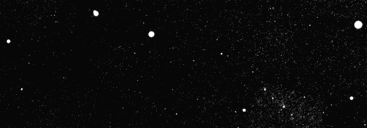 The Big Dipper
This picture of the Big Dipper is not a photograph of mine, but is a mosaic of several
images from the photographic Palomar atlas I've assembled. On the Palomar plates very
faint objects, such as galaxies, are visible. That made me think of the idea of
putting together many plates to make a mosaic where a whole constellation would be
visible at the same time as faint galaxies. In that way you get a unique perspective of
the different scales involved. I haven't counted them, but there are hundreds of galaxies
visible in this image, among the Whirlpool galaxy (M51), NGC3631 (see above), M108
(see below) and the Owl nebula (see below).
The Big Dipper
This picture of the Big Dipper is not a photograph of mine, but is a mosaic of several
images from the photographic Palomar atlas I've assembled. On the Palomar plates very
faint objects, such as galaxies, are visible. That made me think of the idea of
putting together many plates to make a mosaic where a whole constellation would be
visible at the same time as faint galaxies. In that way you get a unique perspective of
the different scales involved. I haven't counted them, but there are hundreds of galaxies
visible in this image, among the Whirlpool galaxy (M51), NGC3631 (see above), M108
(see below) and the Owl nebula (see below).
I've printed a giant poster (1m x 2m) of this image that I've put up in my office.
You may download the image if you want, just bear in mind that it's GIGANTIC:
8000 x 16000 pixels, corresponding to 7.65 MB compressed with jpeg. Uncompressed the
image is 128 MB, which makes it difficult to even display it on most computers. Now
that you are warned, here is the image (7.65 MB).
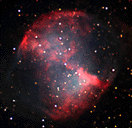 The Dumbbell nebula - M27
The name of this beautiful planetary nebula originates from its clearly asymmetric appearance.
Looking at the nebula through a smaller telescope reveals only the brighter parts, that looks
something like a dumbbell. Planetary nebulae are formed when a dying star throws out large
quantities of gas and dust around itself. Planetary nebulae are often, but not always, very
spherically symmetric.
The Dumbbell nebula - M27
The name of this beautiful planetary nebula originates from its clearly asymmetric appearance.
Looking at the nebula through a smaller telescope reveals only the brighter parts, that looks
something like a dumbbell. Planetary nebulae are formed when a dying star throws out large
quantities of gas and dust around itself. Planetary nebulae are often, but not always, very
spherically symmetric.
This CCD image is composed of 15 exposures in red, green and blue, with a combined exposure
time of 40 minutes. The picture was taken during the Easter Eve morning 2000-04-22.
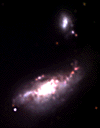 Spiral galaxy NGC4490 and galaxy NGC4485
Also called the Cocoon galaxy. This is an example of two interacting galaxies. The
big galaxy NGC4490 is thought to be a relatively young galaxy of age two thousand
million years, still actively forming stars. In 1982 Paul Wild discovered a supernova
in NGC4490 (Mr Wild seems to be a supernova hunter!). The galaxies seem to be about
3 million light years distant.
Spiral galaxy NGC4490 and galaxy NGC4485
Also called the Cocoon galaxy. This is an example of two interacting galaxies. The
big galaxy NGC4490 is thought to be a relatively young galaxy of age two thousand
million years, still actively forming stars. In 1982 Paul Wild discovered a supernova
in NGC4490 (Mr Wild seems to be a supernova hunter!). The galaxies seem to be about
3 million light years distant.
This CCD image is composed of 15 exposures in red, green and blue, with a combined exposure
time of 40 minutes. The picture was taken during the very first hour of Easter Eve 2000-04-22.
 M65
The spiral galaxy M65 (NGC3623) is turned in a way such that we see it almost edge on,
with a small tilt of only 14 degrees. The left side of the galaxy is the closer
part. Visually dominant in this galaxy is its smooth dark dust lanes. Together
with the galaxy M66 (see below) and NGC3628 it constitutes what's the Leo triplet.
The distance to the triplet is about 22 million light years.
M65
The spiral galaxy M65 (NGC3623) is turned in a way such that we see it almost edge on,
with a small tilt of only 14 degrees. The left side of the galaxy is the closer
part. Visually dominant in this galaxy is its smooth dark dust lanes. Together
with the galaxy M66 (see below) and NGC3628 it constitutes what's the Leo triplet.
The distance to the triplet is about 22 million light years.
This CCD image is composed of 15 exposures in red, green and blue, with a combined exposure
time of 20 minutes. The picture was taken between 20 and 21 o'clock, 2000-04-05.
 M66
The spiral galaxy M66 (NGC3627) is located fairly close to the ecliptic, the plane
in which most bodies in our solar system move. In the upper right corner in this
image one can see a red, a blue and a red dot lined up close to each other. Its
is an asteroid that during the exposures happened to pass the field of view.
With help from
Minor Planet Checker
I identified this asteroid as 2424 Tautenburg.
M66
The spiral galaxy M66 (NGC3627) is located fairly close to the ecliptic, the plane
in which most bodies in our solar system move. In the upper right corner in this
image one can see a red, a blue and a red dot lined up close to each other. Its
is an asteroid that during the exposures happened to pass the field of view.
With help from
Minor Planet Checker
I identified this asteroid as 2424 Tautenburg.
No less than three supernovae have been observed in this galaxy. The first one was discovered in 1973 by Rosino, the second one in 1989 by R.O.Evans and the third one as the first result from a large automated supernova survey by a robotic telescope called Katzman Automatic Imaging Telescope (KAIT). The supernova of 1989 was particularly interesting since it was of type Ia and was discovered very early, seven days prior to its brightness maximum. It thus became very well studied. Supernovae of type Ia are particularly interesting because they all seem to reach about the same maximum brightness. This gives the astronomers a tool to measure distances to galaxies where such supernovae are observed.
This CCD image is composed of 8 exposures in red, green and blue, with a combined exposure
time of 20 minutes. The picture was taken between 21 and 22 o'clock, 2000-04-05.
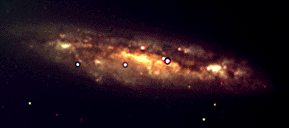 M108
The galaxy M108 (NGC3556) resembles a ghostly glowing cigar with its elongated
shape, edge on as we see it. Prominent are the irregular dust bands. The fact
that the stars in front of the galaxy are surrounded by dark halos is an
artefact of the data reduction, where I've deconvolved the image by using a
conjugate gradient search method with maximum entropy regularisation to sharpen
it up a bit. More on this under the Eskimo nebula below.
M108
The galaxy M108 (NGC3556) resembles a ghostly glowing cigar with its elongated
shape, edge on as we see it. Prominent are the irregular dust bands. The fact
that the stars in front of the galaxy are surrounded by dark halos is an
artefact of the data reduction, where I've deconvolved the image by using a
conjugate gradient search method with maximum entropy regularisation to sharpen
it up a bit. More on this under the Eskimo nebula below.
This CCD image was taken together with Magnus Gålfalk and is composed of 12
exposures in red, green and blue, with a combined exposure
time of 36 minutes. The picture was taken between 22 and 23 o'clock, 2000-02-25.
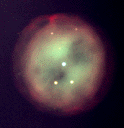 The Owl nebula - M97
The Owl nebula (M97, NGC3587) is one of the biggest planetary nebulae there are,
though somewhat smaller than the Dumbbell nebula. It is thought to be about 3000
light years distant, giving it a physical diameter of 3 light years, but these
figures are very uncertain. The green light from the nebula comes from ionised
oxygen, and the red light from ionised nitrogen.
The Owl nebula - M97
The Owl nebula (M97, NGC3587) is one of the biggest planetary nebulae there are,
though somewhat smaller than the Dumbbell nebula. It is thought to be about 3000
light years distant, giving it a physical diameter of 3 light years, but these
figures are very uncertain. The green light from the nebula comes from ionised
oxygen, and the red light from ionised nitrogen.
In the lower part of the image a star with a fuzzy extension can be seen; I am not certain of its nature, though I have confirmed its reality in other images. It's probably a distant galaxy that just happened to lie in the same direction as a local star.
This CCD image was taken together with Magnus Gålfalk and is composed of 8
exposures in red, green and blue, with a combined exposure
time of 24 minutes. The picture was taken between 21 and 22 o'clock, 2000-02-25.
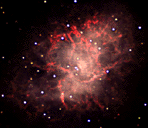 The Crab nebula - M1
In year 1054 some Chinese astronomers observed something very unusual, a supernova
in our own galaxy. The star got so strong that it was visible during daytime for
23 days before it faded away again. At the location of the supernova remains what
is today known as the Crab nebula (M1, NGC1952). By studying the nebula during many
years one has come to the conclusion that it expands at roughly 800 kilometres per
second, and doing some reverse computations reveals that the supernova must have
exploded some 950 years ago, in close accordance with the Chinese observations.
The distance to the nebula is about 6300 light years.
The Crab nebula - M1
In year 1054 some Chinese astronomers observed something very unusual, a supernova
in our own galaxy. The star got so strong that it was visible during daytime for
23 days before it faded away again. At the location of the supernova remains what
is today known as the Crab nebula (M1, NGC1952). By studying the nebula during many
years one has come to the conclusion that it expands at roughly 800 kilometres per
second, and doing some reverse computations reveals that the supernova must have
exploded some 950 years ago, in close accordance with the Chinese observations.
The distance to the nebula is about 6300 light years.
Striking in the Crab nebula are its filaments tracing the field lines of a magnetic field. The strong luminance of the nebula is fuelled by a rapidly rotating neutron star (a so called pulsar). The region emits strongly in radio an x-rays.
This CCD image is composed of 9 exposures in red, green and blue, with a combined exposure
time of 24 minutes. The picture was taken between 21:30 and 22:30, 2000-02-21.
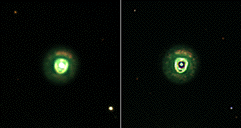 The Eskimo nebula - NGC2392
Yet another beautiful planetary nebula. Here I show the same image two times, one before
and one after the deconvolution (sharpening) of the image. As can be seen, the image
really gets sharper and more detail is revealed but at the expense of the introduction
of some artefacts, one being the dark halos around bright stars. The Hubble Space Telescope
has snapped an astonishing picture of this nebula, about 20 times sharper than mine. You can
find it here.
The Eskimo nebula - NGC2392
Yet another beautiful planetary nebula. Here I show the same image two times, one before
and one after the deconvolution (sharpening) of the image. As can be seen, the image
really gets sharper and more detail is revealed but at the expense of the introduction
of some artefacts, one being the dark halos around bright stars. The Hubble Space Telescope
has snapped an astonishing picture of this nebula, about 20 times sharper than mine. You can
find it here.
This CCD image is composed of 34 exposures in red, green and blue, with a combined exposure
time of 17 minutes. The picture was taken between 20:30 and 21 o'clock, 2000-02-21.
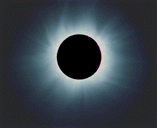 Total Solar Eclipse 1999
The photograph of the total solar eclipse is from the 11:th of August, 1999 from the Black Sea
cost of Bulgaria. A solar eclipse is difficult to photograph because of the large dynamic
range of the light from it. Close to the limb you find the relatively strong red prominences.
Outside there is the solar corona, fairly strong nearby but fading very quickly although
extending several solar radii. To get the whole dynamic range well exposed in a single
exposure is impossible with available photographic film, unless you have some sort of a
radial filter; either the inner part gets over exposed, or the outer gets under exposed.
Instead, in this image, I combined four exposures with exposure times of 1/60:th, 1/2,
1 and 2 seconds. I've put the photographs together digitally and enhanced contrast at
different intensity levels by using an unsharp mask.
Total Solar Eclipse 1999
The photograph of the total solar eclipse is from the 11:th of August, 1999 from the Black Sea
cost of Bulgaria. A solar eclipse is difficult to photograph because of the large dynamic
range of the light from it. Close to the limb you find the relatively strong red prominences.
Outside there is the solar corona, fairly strong nearby but fading very quickly although
extending several solar radii. To get the whole dynamic range well exposed in a single
exposure is impossible with available photographic film, unless you have some sort of a
radial filter; either the inner part gets over exposed, or the outer gets under exposed.
Instead, in this image, I combined four exposures with exposure times of 1/60:th, 1/2,
1 and 2 seconds. I've put the photographs together digitally and enhanced contrast at
different intensity levels by using an unsharp mask.
The images were taken through a refractor telescope of focal length 900 milimetre on
Kodachrome 64 film in company with
Markus Dimdal ,
Martin Rehn and Mattias Widmark whom I travelled
together with to Bulgaria to watch the eclipse.
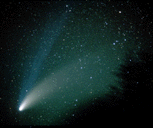 Comet Hale-Bopp
This photograph of the giant comet is from March the 20:th 1997, 22 o'clock. The
film used was Fuji's Provia 1600 ASA, colour slides, and I used a piggybacked
camera with a 200 mm lens. Exposure time 5 minutes. You can clearly see both
the blue plasma tail and the greenish dust tail in this picture. If you look
carefully you can also see the colours of the background stars. Some are red,
others are blue. The picture was taken in company of Daniel Sindahl, Lina Sjölin
and Malin Siddiqi.
Comet Hale-Bopp
This photograph of the giant comet is from March the 20:th 1997, 22 o'clock. The
film used was Fuji's Provia 1600 ASA, colour slides, and I used a piggybacked
camera with a 200 mm lens. Exposure time 5 minutes. You can clearly see both
the blue plasma tail and the greenish dust tail in this picture. If you look
carefully you can also see the colours of the background stars. Some are red,
others are blue. The picture was taken in company of Daniel Sindahl, Lina Sjölin
and Malin Siddiqi.
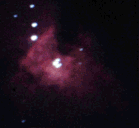 The nebula of Orion - M42
The photograph is from February the 3:rd 1995, captured on an Ektachrome 400
ASA with exposure time 60s, which even that is a little too much
because of the inaccurate telescope drive. You can see that on the
stars which are not circular as they should be, but elliptic. In the
middle of the nebula you see the Trapezium, the four brightest
members of the multiple system Theta Orionis. The age of this central
part of the Orion nebula seems to be roughly 30000 years, about the same
as the brighter Trapezium stars. In other words, it's one of the youngest
nebulas in the sky. The distance to this glowing gas cloud is somewhat
uncertain, but is on the order of 1000 light-years.
The nebula of Orion - M42
The photograph is from February the 3:rd 1995, captured on an Ektachrome 400
ASA with exposure time 60s, which even that is a little too much
because of the inaccurate telescope drive. You can see that on the
stars which are not circular as they should be, but elliptic. In the
middle of the nebula you see the Trapezium, the four brightest
members of the multiple system Theta Orionis. The age of this central
part of the Orion nebula seems to be roughly 30000 years, about the same
as the brighter Trapezium stars. In other words, it's one of the youngest
nebulas in the sky. The distance to this glowing gas cloud is somewhat
uncertain, but is on the order of 1000 light-years.
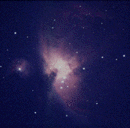 The nebula of Orion - M42
This picture is taken in February 1995 on an Ektachrome P1600 ASA pushed up to
3200 ASA. The exposure time is 60s here too, but thanks to the greater
sensivity of the film more of the outer regions of the nebula gets
visible. The Trapezium on the other hand, is almost completely hidden
in the overexposed middle region. Compared to the previous picture,
this one is rotated 180 degrees.
The nebula of Orion - M42
This picture is taken in February 1995 on an Ektachrome P1600 ASA pushed up to
3200 ASA. The exposure time is 60s here too, but thanks to the greater
sensivity of the film more of the outer regions of the nebula gets
visible. The Trapezium on the other hand, is almost completely hidden
in the overexposed middle region. Compared to the previous picture,
this one is rotated 180 degrees.
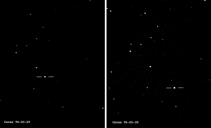 Ceres
These two pictures of Ceres are taken on March the 29:th and the 30:th 1995
respectively, with
Kodak T-MAX 3200 ASA. You can clearly see how the asteroid has moved between
these two occasions. The pictures are centred on the celestial
coordinates (8h54m;31°0') and the field of view is about 0.5 degrees. The
faint stars in the background are of an approximate magnitude of 9.
Ceres
These two pictures of Ceres are taken on March the 29:th and the 30:th 1995
respectively, with
Kodak T-MAX 3200 ASA. You can clearly see how the asteroid has moved between
these two occasions. The pictures are centred on the celestial
coordinates (8h54m;31°0') and the field of view is about 0.5 degrees. The
faint stars in the background are of an approximate magnitude of 9.
 The constellation of Lyra
The picture represents the constellation of Lyra, also photographed
from the Greek island in 1995. The exceptionally bright star in the upper
right
corner is one of the brightest stars on the celestial sphere, Vega.
The constellation of Lyra
The picture represents the constellation of Lyra, also photographed
from the Greek island in 1995. The exceptionally bright star in the upper
right
corner is one of the brightest stars on the celestial sphere, Vega.
The constellation is often drawn as a parallel trapezium with Vega and
the double star as a prominent triangle. Used film was Kodak T-MAX 3200 ASA
and exposure time 60s. The lens was a 28-70mm zoom lens. The picture was obtained
in company of Jonas Kämpe.